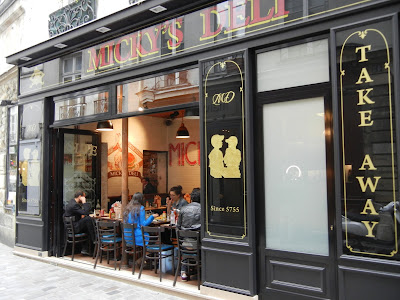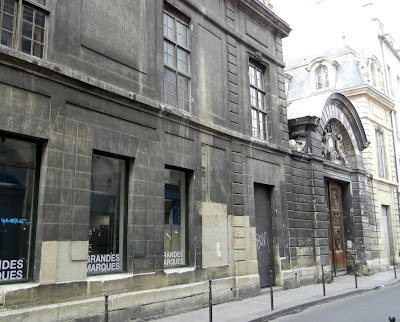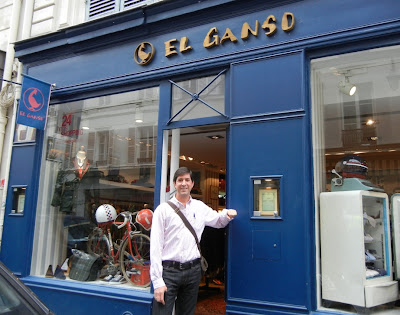There are many ways to reach Le Marais, a historic district in Paris located in the 3rd and 4th arrondissements. Our trip started at the Place de la Bastille, where the Bastille prison stood until the French Revolution. At the center of the square stands the July Column, which commemorates the events of the July Revolution of 1830, which lasted "three glorious days" and resulted in the overthrow of Charles X, the last French Bourbon monarch, and the ascent of his cousin Louis Philippe, Duke of Orléans, who agreed to rule as a constitutional monarch. Next to Place de la Bastille is the north end of the Arsenal marina, which connects to the Seine.
It's a beautiful symmetrical square surrounded by buildings with red brick and white stone façades, steep slate roofs and dormer windows, built over vaulted arcades that stand on square pillars. The façades all have the same design, and all the buildings are of uniform height except the King's Pavilion, on the south side, built by Henri IV for his own use but which he didn't live to see completed, and the Queen's Pavilion on the north side.
On the four sides of the square are rows of carefully pruned lime trees. The square itself has the traditional lawns and gravel paths, four round trickling fountains, and in the center is a huge equestrian statue of Louis XIII. This one is from 1825; the original, commissioned by his chief minister, Cardinal Richelieu, was melted down during the French Revolution.
There were many notable residents, including Sully, the minister of finances of Henri IV, Richelieu, and later Victor Hugo, whose house is now a museum devoted to his memory. The beautiful Arcades are now filled with chic art galleries and antique shops, fancy restaurants, and fashionable boutiques.
In Paris, Paris, Journey into the City of Light, a very personal and intimate view of the city, David Downie suggests the best way to approach Place des Vosges is to take Rue de Birague, once called Rue Royale: "Framing its northern end is the Pavillon du Roi... Through two of the arches supporting it, you get a keyhole view of the square beyond."
For some time, especially after Place des Vosges was built, the Marais (which used to be a marsh) was the French nobility's favorite place of residence. So we walked a couple of blocks west, looking for some of the few remaining mansions, some of which actually preceed Place des Vosges. We saw the Hôtel Lamoignon, which was bought and restored by the city of Paris and is now the Paris Historical Library; the turreted Hôtel de Sens on Rue de l'Hôtel de Ville (now another library); and the Hôtel Amelot de Bisseuil, also called Hôtel des Ambassadeurs de Hollande, whose most notable resident was Beaumarchais, the author of The Barber of Seville and The Marriage of Figaro, among other achievements (he also also raised money and weapons for the American revolutionaries). Loved the Medusa heads on the imposing carriage doors.
We visited the Hôtel Carnavalet, a museum of the History of Paris. In the courtyard there's a magnificent sculpture of Louis XIV, who seems to greet visitors. The museum exhibits show the transformation of the village of Lutece, which was inhabited by the Parisii tribes, through the Middle Ages, the Renaissance, the Revolution, to today.
Unfortunately we missed the Hôtel de Sully, owned by the Duke of Sully; we'll have to go some other time.
Suddenly, it felt as if we'd left Paris and were in the Middle East. Jewish shops, restaurants, bakeries, even a few falafel sandwich stands, like the now famous L'As du Fallafel, where they still hand out passersby cheap printouts of a 2006 New York Times article in which they were featured. We were on Rue des Rosiers, the main street of Paris's Jewish quarter.
 |
One of those Jewish shops is called Panzer, a kosher butcher shop named after its owner, Dimitri Panzer. Panzer was born during the Second World War, and thanks to the protection of a French family, he managed to escape the raids and deportations. The store, which is now run by his son, opened in 1979 under his own name, but the irony seems to be lost on them.
After the nobility started to move to the Saint Germain and Saint Honoré neighborhoods, the area became popular with working class and Jewish communities. It was declared a secteur sauvegardé during Charles de Gaulle's government and went through a process of restoration and rehabilitation. It made such a renewal that today it's a very fashionable district, full of boutiques and art galleries, trendy shops and cafes. We had a great lunch at one of those places, Le Loir dans la Théière, named after the Dormouse who gets dunked in the teapot in Alice In Wonderland. Don't come here if you like fancy; this place is about comfort food and a great atmosphere and the tallest lemon meringue.



























